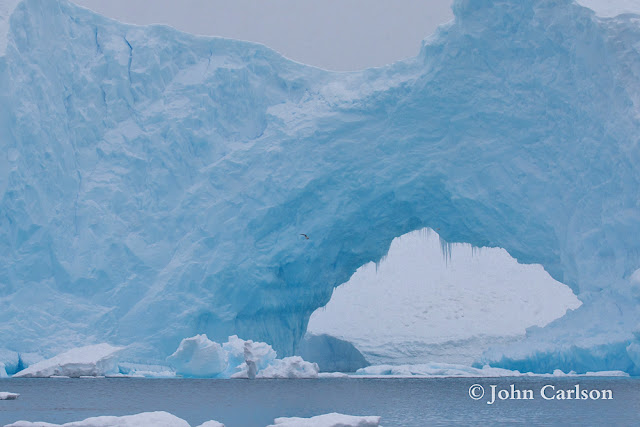On the afternoon of January 12, 2015 I was immersed in a surreal setting of ice, snow and water. We were just west of Booth Island and north of Pleneau Island on the Graham Coast of the Antarctic Peninsula. Above me in the clouds to the east were Mt Shackleton and Mt. Scott, but I had to trust the map to tell me that. There were no mountains to be seen that day. The clouds were low and large flakes of snow floated from the what was left of the sky, seemingly spontaneously forming just above our heads.
We were there because of the icebergs. This area is a frequent stop of tour ships because the currents and islands conspire to push icebergs into this area where they slowly decay into constantly changing abstract sculptures.
The day had started out with a curious Minke Whale checking out our Zodiacs as the staff prepared to transport guests to Peterman Island where we were able to visit colonies of breeding Gentoo and Adelie Penguins with a few Blue-eyed Shag nests in the mix.
 |
| Sandra and her friend the curious Minke Whale. |
 |
| A chunk of bar ice where you can see how the water erodes small cup shaped divots from the ice. Photo by Sandra Petrowitz. |
They were perched high on the ramparts of towering bergs in an Antarctic version of birds on a wire.
The migration of this species is quite remarkable. They breed in their namesake region - the Arctic, but then migrate south through the Atlantic Ocean (and probably the Pacific Ocean as well) to spend their non-breeding summer in the Antarctic Pack ice. We know more about the portion of the population the migrates through the Atlantic through some interesting research conducted on Arctic Terns in Greenland and Iceland known as the Arctic Tern Migration Project. Below are a couple of maps that show the migration route and winter areas of the eleven birds they tracked (both images from the Greenland Institute of Natural Resources)
One iceberg in particular formed a spectacular eroded backstop for the foraging terns.
There were a few other creatures foraging in the same area with the terns. We observed another less inquisitive Minke Whale that afternoon as well as a Crabeater Seal lounging in an iceberg pool and a few Kelp Gulls.
So why did I see so many on this trip? One explanation is that I just hadn't been in the right place at the right time and they have always wintered in this area. However, I believe that this year the pack ice was so heavy in the Weddell Sea that there was essentially no open water and the birds wound up concentrating along the Antarctic Peninsula in numbers that would not be found during a "normal" year just to be able to find something to eat.
Perhaps a more fitting name for this bird would be the Polar Tern, since they spend a majority of their life in both polar areas where they also experience perpetual daylight. The distances these birds migrate is impressive and when they are not breeding or wintering in the polar regions they are flying in a twisted migration loop back and forth across the Atlantic Ocean.




















